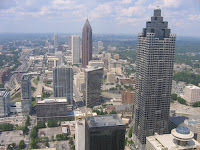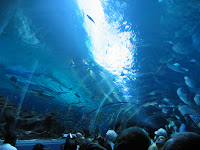Despite what
Bucks Fizz had to say on the matter, I don't have to "be sure that it's something everybody's going to talk about before [I] decide the time's arrived for making [my] mind up." Still it would be nice to stop revising these rail plans. Of course in the real world (as opposed to the academic exercise shown below), plans are almost always fluid.
I have responded to your comments on my transit plan for Washington, originally posted
here with a revised proposal.

The main changes I made were the extension of the Southeast Light Rail (now called the Eastside Light Rail), the line colored lime on the map, from Minnesota Avenue up to Columbia. I also separated the Silver Line from the Orange and Blue Lines based on WMATA's recent release of the
Station Access and Capacity Study. I've routed the Blue Line along M Street, while taking the Silver Line through the heart of downtown, under H Street. I also instituted "Airporter" service which would operate on the Silver Line from Union Station to Dulles, operating express from East Falls Church to the Airport, with an intermediate stop at Whiele Avenue (more on that later).
The Eastside Light RailThis newly-dubbed light rail transitway will extend from National Harbor to Minnesota Avenue Metro over the alignment described in my earlier post. North of Minnesota Avenue, the Eastside will parallel the Orange Line to Deanwood, then follow the Alexandria Branch of the B&O (now CSX) to Bladensburg and Hyattsville. Trains then parallel the Camden Line through Riverdale to College Park Metro, where an interchange can be made to the Green and Purple Lines. The line then joins the Purple Line briefly along Paint Branch Parkway, splitting to follow the
ex-Rhode Island Avenue Trolley right-of-way toward Beltsville.
Outside of the Beltway, the line turns to follow on the east side of Route 1 to Powder Mill Road, where it will run adjacent to the CSX Capital Subdivision once again. At Muirkirk, passengers can change to the Camden Line. The line then turns to run along the Intercounty Connector to Interstate 95, where the line turns north in the median. At Maryland Route 32, the line turns west toward Columbia. The Columbia stops are accessed while the line runs at grade alongside Broken Land Parkway to Columbia Mall.
East-West Subway Service DowntownAccording to WMATA's recent
Station Access and Capacity Study, the Orange Line will be overburdened by 2025 even if 100% 8-car trains are operated. These figures assume that the Silver Line will be constructed and that the Blue Line will run some trains to Greenbelt as
proposed earlier this year. Personally, I like Greater Greater Washington's proposal to
brand it as a Yellow Line shift.
Based on this report and reader comments, I have decided to rethink the idea of east-west Metro access through downtown. The only way to add capacity in an east-west direction is to build a new subway. Under WMATA's proposal, trains will already be operating at their maximum length and headway. The report did resurrect the idea of an M Street Subway, which I proposed in the first iteration of my rail plan as Silver, but I'm not sure the plan goes far enough.
One of the criticisms of WMATA is that no express service is provided. It will be difficult, if not impossible, to retrofit the existing stations due to their monolithic nature to handle additional tracks or platforms. However, a parallel subway would take demand off of the overcrowded conditions on the existing Blue and Orange Lines, especially if its stops were more limited.
Limited Stops in the Rosslyn-Ballston CorridorMy proposal for the Silver Line calls for a new tunnel to be constructed from I-66 to Rosslyn, parallel to the Orange Line between Rosslyn and Ballston. In this section, a stop would be included at Glebe Road (at Wilson) to serve the jobs in the area, but would
not include an interchange to the Orange Line at Ballston. Silver trains would then (in the new subway) proceed directly to Rosslyn with no intermediate stops.
The new subway could be constructed under (from west to east) Fairfax Drive, Glebe Road, Wilson Boulevard, 10th Street N, Arlington Boulevard, and Fort Meyer Drive.
On the western end of the corridor, Silver Line trains would operate in the median of I-66 on the outside two tracks of a new four-track line. East Falls Church Station would be redesigned with two island platforms and four tracks. Silver trains would then shift to the Dulles Toll Road without sharing tracks with the Orange Line.
Rosslyn RedesignThe Rosslyn Station would consist of 3 island platforms and 6 tracks. The existing station, under North Lynn Street would continue to operate in its current form, but only serving Blue Line trains. On the Blue Line, Rosslyn would be between Arlington Cemetery and Georgetown. The Blue Line would use the new M Street subway I proposed before as Silver to access downtown.
A new part of the station would be constructed just west of the present station, under Fort Meyer Drive. This station would have two levels of trains, with westbound trains on the two upper level tracks and eastbound trains on the lower level. At Rosslyn the Silver and Orange Lines would have their own tracks and would not be mixed. The Orange Line would continue east over its current alignment to Foggy Bottom while the Silver Line would operate in a new H Street Subway.
H Street SubwayFrom Rosslyn, the Silver Line would cross under the Potomac in a new tunnel, continuing under H Street NW. The line could be bored deep under the Watergate, or it could cross the Potomac next to the present Metro tunnel and jog south to H under Virginia Avenue. Continuing east under H, the line would
not stop in Foggy Bottom. It would jog north to follow H under the triangle parks at Pennsylvania Avenue. A Farragut Square station would be constructed at 17th Street, with pedestrian connection (fare paid) under 17th to connect to the existing Farragut West (Orange) Station under I Street, the existing Farragut North (Red) Station under Connecticut Avenue, the proposed Blue Line/Regional Rail Tunnel Station under K Street, and the proposed Westside (Baby Blue) Light Rail Station cutting diagonally under Farragut Square itself.
Continuing under H Street, the line would add platforms at the north end of Metro Center (H/12th) and at the north end of Gallery Place (H/7th) for easy transfer to the Red/Orange and Green/Yellow Lines. Just after jogging north to continue under H Street at Massachusetts Avenue, the line would include a Blue Line interchange at the New Jersey Avenue station. The final stop on the western H Street segment would be Union Station/NoMa. This station would be located under H Street and could connect to a new commuter rail concourse for MARC trains. A walkway could also be constructed (fare paid) to connect with the northern mezzanine at the existing Red Line Union Station platforms.
Old City/Capitol HillTransit service in this part of Washington would be greatly improved in my plan. Because both the Blue and Silver Lines need to continue toward the suburbs, it seems to make sense to build both subways. Additionally, building the M Street (Blue) Subway under Massachusetts Avenue allows for a more direct connection to the Red Line at Union Station. Meanwhile, the H Street Subway (Silver) would continue under H Street NE to Benning Road and D&G Junction.
BLUE:
From the New Jersey Avenue station, Blue Line trains turn southeast under Massachusetts Avenue, making stops at Union Station, Capitol Hill (Stanton Park), and Lincoln Park. East of Lincoln Park, the subway would turn under North Carolina Avenue then C Street NE. Near RFK Stadium, trains would emerge from subway to join the Orange Line viaduct (on their own tracks). A new 4-track station would be constructed at Oklahoma Avenue (existing Metro viaduct, just south of Benning Road). This station would keep the Blue and Orange Lines separate all the way to D&G Junction to eliminate interlining. A fare paid connection would exist to a Silver subway station under Benning Road (also called Oklahoma Avenue).
SILVER:
Continuing under H Street and the Union Station platforms, the line would include a station at H and 6th NE (H Street/Old City) and Atlas District (H and 14 NE). Finally, the line would turn under Benning Road and include a station at Oklahoma Avenue. Some trains would terminate there, and two layup tracks would exist east of the station. However, rail connections will be constructed to allow revenue Silver trains to continue east to serve New Carrollton and Largo.
 Airporters
AirportersA new concept in my plan would provide a faster trip from Dulles to downtown. From Union Station to East Falls Church 'Airporter' trains would share tracks with the Silver Line. Once in the median of the Dulles Toll Road, however, these trains would get their own set of tracks which would bypass the four Tysons Corner stations by staying in the median. A 4-track Whiele Avenue Station would allow passengers to transfer to "local" Silver trains. After While Avenue, Airporters would be express to Dulles Airport, where trains could turn back on a center track at the platform (like National Airport) or proceed through and use a turnback loop west of the station (like Brooklyn Bridge on the #6).
These trains would allow passengers coming from Ryan Road to change for a faster trip to downtown in addition to allowing flyers a shorter time on the Metro. From Dulles to Farragut Square on an Airporter is only 6 stops. On a Silver train there are 12, and that number is 16 under Metro's current proposal, running Silver trains along the existing Orange Line.
While sharing tracks from Union Station to East Falls Church would degrade express service, I don't think it's feasible to construct 2 more tracks through downtown. Besides, if we assume that trains can operate every 135 seconds (current design capacity at Rosslyn), in a 10 minute period, 4.4 trains can pass a given point. Since Metro says higher frequencies can be produced without switch realignment (like at Rosslyn) we can assume that more trains can fit through, perhaps up to 5 in a 10 minute period.
If that is the case, 1 out of every 5 Silver trains could be an Airporter, giving a 10 miunte headway, while service on the Silver Line west of EFC is 2.5 minutes apart on average and 2 minutes apart downtown. Of course, WMATA could adjust service necessarily, but I don't think a lack of separate Airporter tracks downtown will make the service infeasible.

Anyway, that's my revised proposal. I'd love to hear what you think about it. Thanks for the comments last time. And sorry if I've made the map even busier. I don't have a graphic design background, so I just muddle along.
*Since so many of you have asked, I use
Inkscape for my graphics. It is a freeware product similar to Adobe Illustrator. I have only scratched the surface of its potential.
 As I have mentioned before, I will be setting off on the journey of a lifetime tomorrow. I will be riding the rails clear across Canada, from Atlantic to Pacific.
As I have mentioned before, I will be setting off on the journey of a lifetime tomorrow. I will be riding the rails clear across Canada, from Atlantic to Pacific.






















